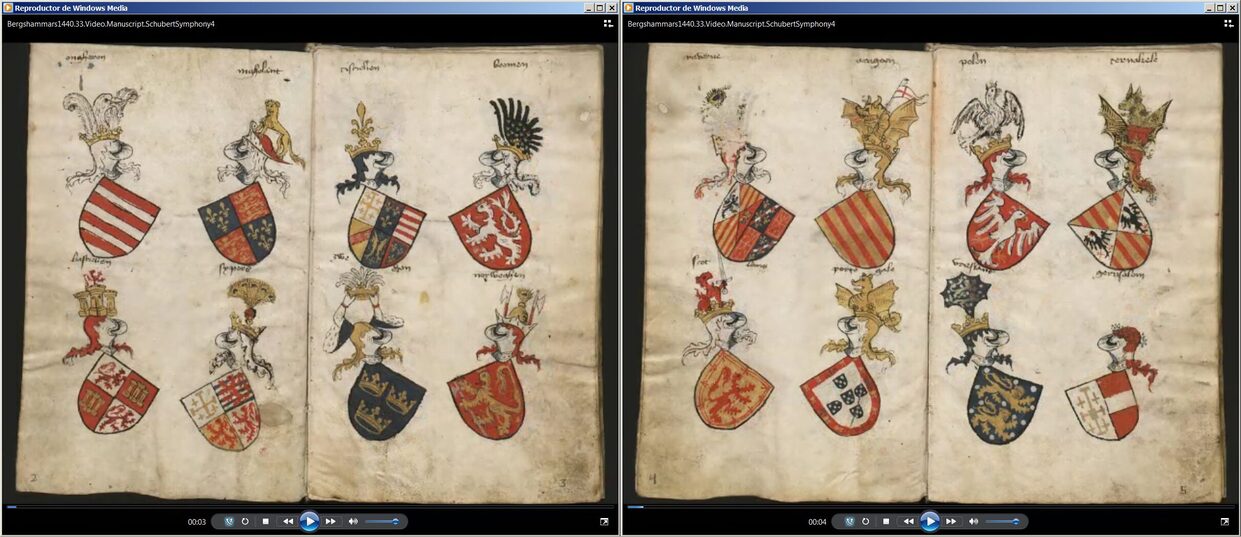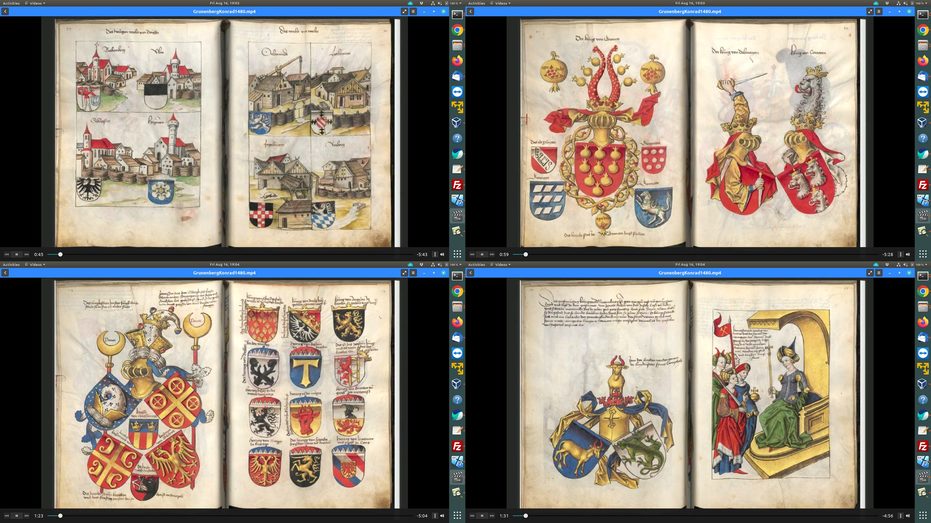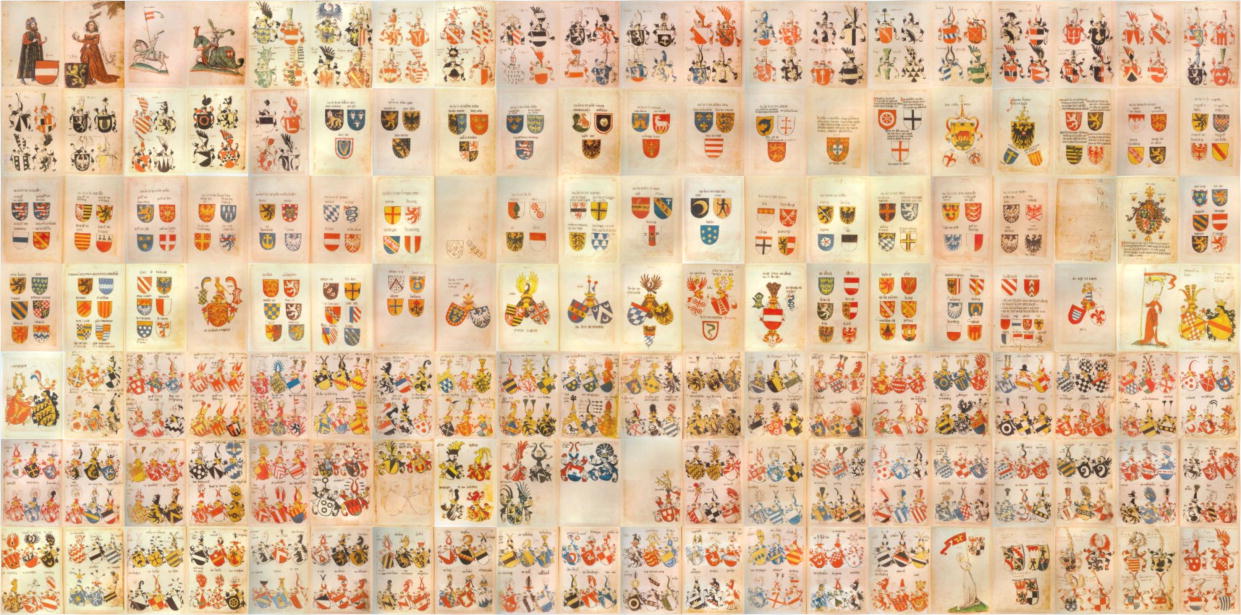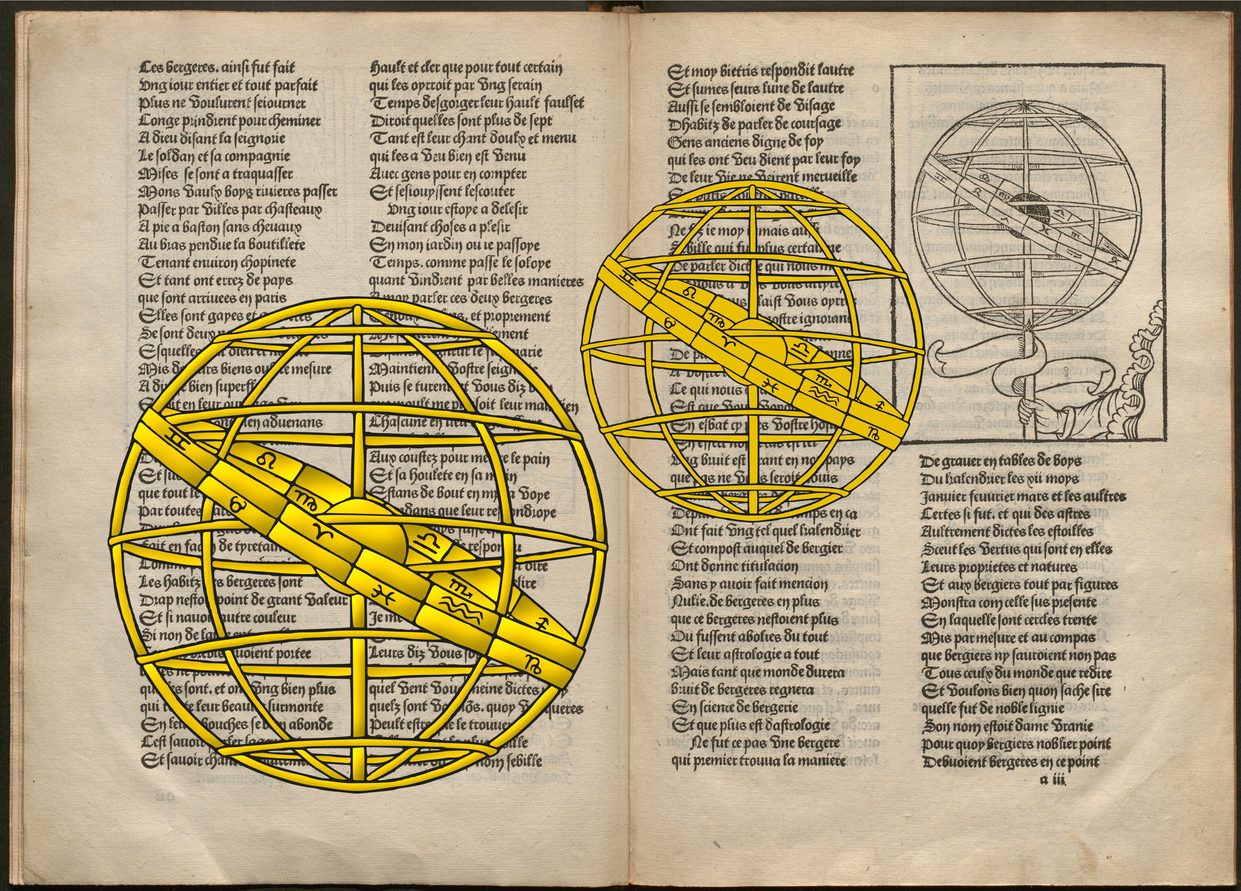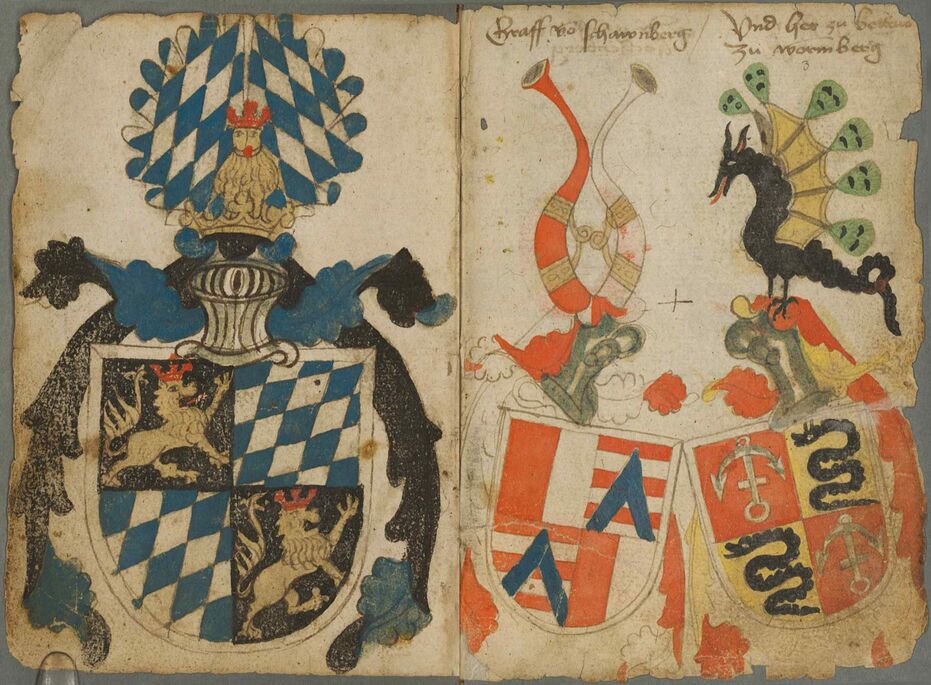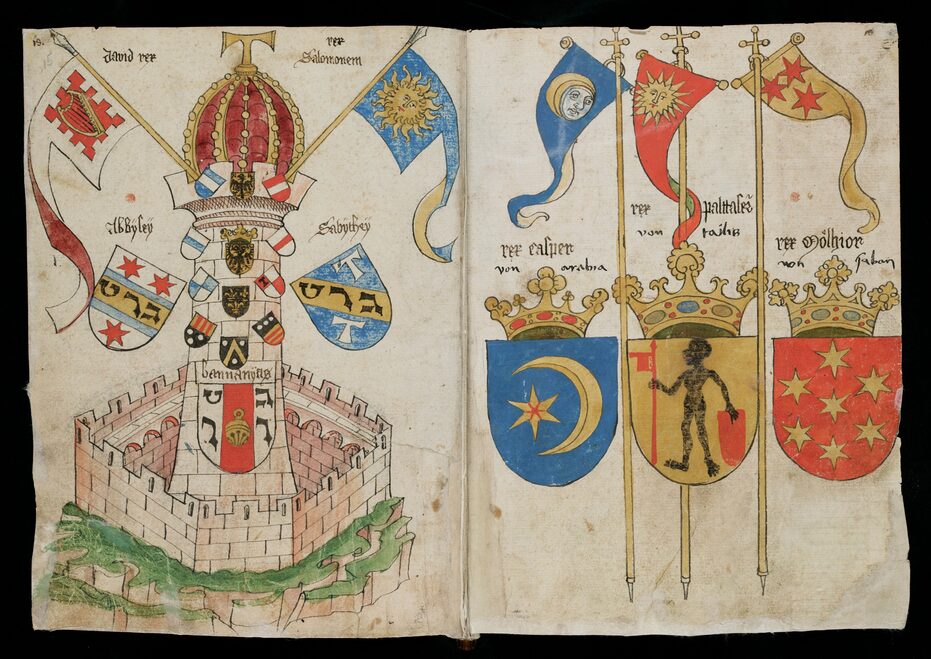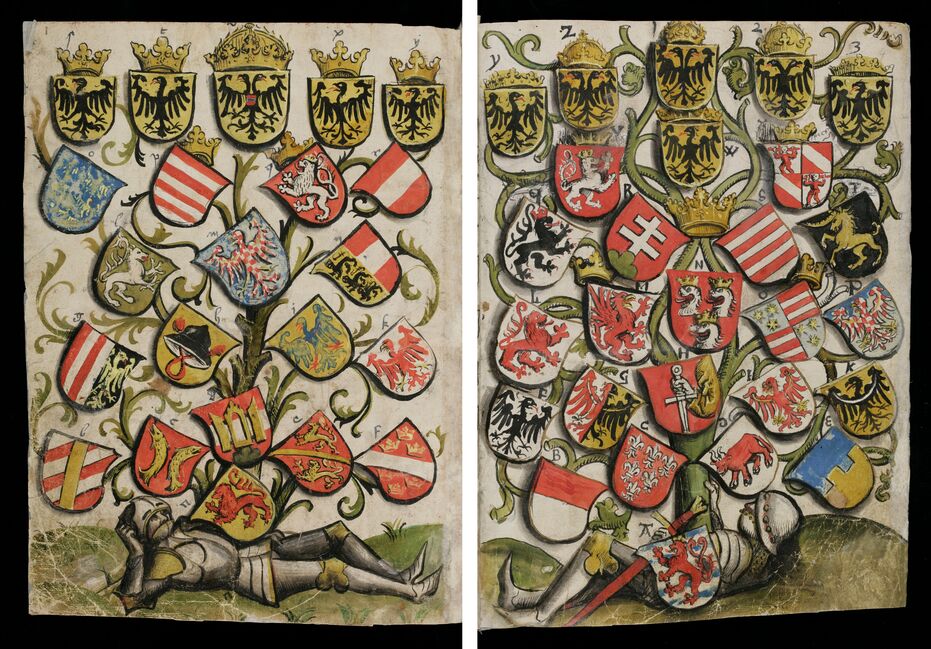Century XV


![Ver [Bergshammars; 1440] en referencias bibliográficas. Libro abierto, hojas de plata, filo de oro, guardas de gules, tapas de sable.](../css/Libro.Bibliografia.png)
Bergshammars; 1440
Anonymous, «Roll of arms», roll of arms manuscript called Bergshammars, written, emblazoned and edited in Brabant, Burgundian Netherlands, during the years 1440-1456, 493 pages numbered later in pencil, contains coats of arms of several European kingdoms, on page 488 the year 1553 seems to be written, Brabant, ca 1440.
Bibliographical reference of century XV.
Classification: Armorial roll, Manuscript and In color.
The author is anonymous.
The following articles cite this bibliographic reference:
External links:
Internal resources: Bergshammars1440.33.Video.Manuscript.SchubertSymphony4.mp4 a video lasting 7 minutes and 11 seconds, sound track Symphony No. 4 in C minor, D 417, called Tragic, composed by Franz Schubert in April 1816, when he was 19 years old.


![Ver [Edward IV of England; 1461] en referencias bibliográficas. Libro abierto, hojas de plata, filo de oro, guardas de gules, tapas de sable.](../css/Libro.Bibliografia.png)
Edward IV of England; 1461
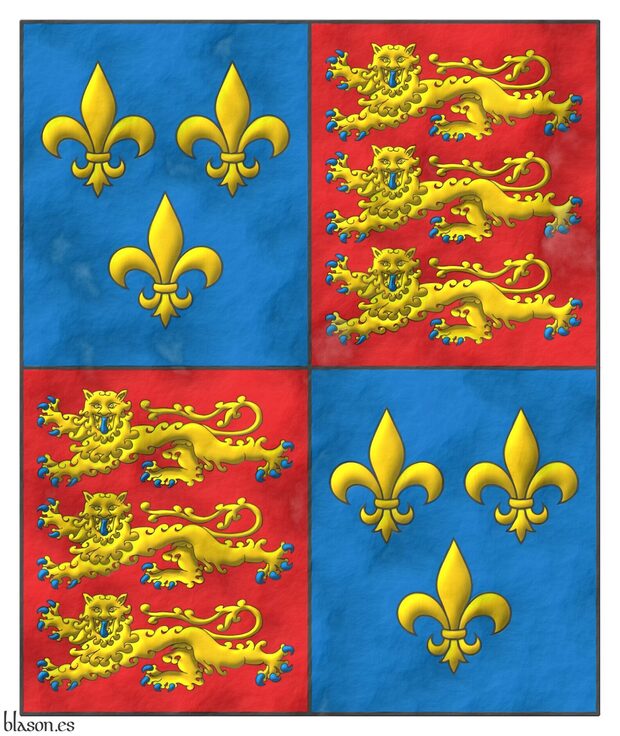
Edward IV King of England and Lord of Ireland, «The Armorial of Edward IV», «The Edward IV Roll», armorial in the form of a roll about 6 meters long, created to celebrate the coronation of Edward IV as the first King of England from the House of York and illustrated, probably, by different artists, 1461.
The image illustrating this reference corresponds to the banner, which is number 27 in the 2nd column, the final one of this armorial. This banner is held by a white deer, which was a personal badge of King Richard II of England, and also, two white deer were the supporters of his shield. The reason for the inclusion of this white deer might be to contribute to the legitimization of Edward IV as king.
It is notable that in row 25 of the 2nd column of this armorial there is a banner with the arms of the shield of Castilla y León, probably because Edward IV, like his predecessors, claimed their throne. In this version of the shield of Castilla y León:
- The two gold castles, in the 1st and 4th quarters of gules, have three towers with the central one taller like the Castilian, but the twin side towers seem to be connected by the wall as in the English castle, [Valero de Bernabé, L.; 2009a; page 2] and [Valero de Bernabé, L.; 2009b; page 33], the wall has a door that is enameled in azure as in the Castilian.
- The two lions, in the 2nd and 3rd quarters of silver, seem to be gold, therefore, of «metal on metal» and, furthermore, very different from the purple lion of Castilla y León, it could well be an error by the artist or a degradation of an original purple enamel to ochre, as explained in the pendón de Castilla y León.
This shield of Castilla y León also appears:
- On the banner in row 27 of the 1st column of this armorial. In this banner, they are combined with the arms of England represented in this article, in a new quartered, under an escutcheon with the imaginary arms of «Brutus of Troy», the also imaginary founder and king of Britain.
- On the caparison of the horse that Edward IV rides in the portrait at the beginning of his armorial. This caparison is a reproduction of the previous banner in row 27 of the 1st column that combined the arms of England with those of Castilla y León. The presence of these arms in this initial portrait of the armorial of Edward IV denotes the importance he gave to his aspirations to the crown of Castilla y León.
Bibliographical reference of century XV.
Author: Edward IV of England.
Bibliographic reference mentioned in the following articles:
- Banner of Castile and León
- Brutus of Britain
- Brutus of Britain, banner
- Charles V of France
- Edward IV of England
- Edward IV, armorial for His coronation
- Edward IV, quartered con Castile and León
- Heraldica Nova
- King Arthur, 3 crowns in pale
- King Arthur, banner with 3 crowns in pale
- King Arthur, banner with cross flory
- King Arthur, cross flory
- Leonor de Aquitania
- Pendón con inescutcheon de Edward IV
External resources:


![Ver [Grünenberg, K.; 1480] en referencias bibliográficas. Libro abierto, hojas de plata, filo de oro, guardas de gules, tapas de sable.](../css/Libro.Bibliografia.png)
Grünenberg, K.; 1480
Konrad Grünenberg, «Das Wappenbuch Conrads von Grünenberg, Ritters und Bürgers zu Constanz», Münchener DigitalisierungsZentrum, Bayerische Staatsbibliothek, call number Cgm 145, 182 leaves, parchment, 37 x 31 centimeters, manuscript in German, circa 1480.
Contents
The «Wappenbuch» by Konrad Grünenberg is a splendid manuscript featuring several hundred colored coats of arms. Written on parchment, this manuscript is believed to be a contemporary copy of the original version on paper, which was completed in 1483 and is currently preserved in Berlin. This manuscript was once part of the Bavarian dukes' library and was likely owned by Duke Wilhelm IV of Bavaria, 1493-1550. It depicts coats of arms of barons, dukes, margraves, archbishops, free cities and towns, and orders of knights from across Germany, as well as royal coats of arms from various European kingdoms.
Provenance
The manuscript is linked to Konrad Grünenberg, a prominent burgher and knight from Konstanz, a town on Lake Constance in southwestern Germany. Although the exact dates of his birth and death are unknown, Grünenberg was first mentioned as a builder in 1442. He devoted much of his life to heraldry, resulting in the creation of this armorial that bears his name. This specific copy is one of several made from Grünenberg's original autograph.
Creative Commons
The manuscript is fully digitized and available for study, and is licensed under the Creative Commons Attribution-NonCommercial-ShareAlike 4.0 International.
Bibliographical reference of century XV.
Classification: Armorial roll, Manuscript, German language and In color.
The author is Grünenberg, Konrad.
External resources:
Internal resources: GrunenbergKonrad1480.mp4 Video in MP4 format and GrunenbergKonrad1480.pdf Armorial in PDF format.

![Ver [Ingeram, H.; 1459] en referencias bibliográficas. Libro abierto, hojas de plata, filo de oro, guardas de gules, tapas de sable.](../css/Libro.Bibliografia.png)
Ingeram, H.; 1459
Hans Ingeram, «Ingeram Codex», 142 pages, 1459.
The first owner of this armorial was Archduke Albert VI of Austria. Hans Ingeram included in each page of his book from 1 to 6 coats of arms, he dedicated the initial part to the Habsburg coats of arms, to imaginary coats of arms and to the coats of arms of European kingdoms, generally using 4 coats of arms per page, and dedicated the final 2/3 of its content to depicting 6 coats of arms per page of the lower German nobility, especially nobles belonging to a special type of «associations» whose purpose was the organization of tournaments. A monograph on this armorial can be consulted in [Becher, C.; Gamber, O.; 1986].
Bibliographical reference of century XV.
Classification: Manuscript and Armorial roll.
The author is Ingeram, Hans.
Here are the articles quoting this reference:
External links:


![Ver [Marchant, G.; 1499] en referencias bibliográficas. Libro abierto, hojas de plata, filo de oro, guardas de gules, tapas de sable.](../css/Libro.Bibliografia.png)
Marchant, G.; 1499
Guy Marchant, printer, «Compost et Kalendrier des Bergères», 68 folio leaves, more than 80 woodcut illustrations, Paris, August 17th, 1499.
This work complements the «Kalendrier des Bergiers» (1491), intended for a male audience, while this «Compost» is aimed at women readers, «Calendar of the Shepherdesses». Both books combine astrology, medicine, Christian morality, and practical advice. It includes numerous didactic woodcuts.
The image shows a golden armillary sphere, to be used in one of the versions of the coat of arms of Jean-Christophe Loubet del Bayle, extracted by me from one of the astrological pages of this book, page 15, «a iii».
In [Fernández de Enciso, M.; 1519; page 1] there is also an armillary sphere that bears certain similarities to the one appearing in [Marchant, G.; 1499; page 15]. A comparison of the bands with zodiac symbols of both spheres can be seen in [Fernández de Enciso, M.; 1519].
Bibliographical reference of century XV.
Classification: In black and white, French language and Incunabulum.
Author: Marchant, Guy.
Bibliographic reference mentioned in the following articles:
External links:
- Historical Library of Marquis of Valdecilla.
- Catalogue entry and full text.
- In the Digital Heritage of the Complutense University of Madrid.
Internal resources: MarchantG1499.CompostEtKalendrierDesBergeres.UCM.pdf, scanned PDF version from the Historical Library of the Complutense University of Madrid.


![Ver [Ortenburg; 1473] en referencias bibliográficas. Libro abierto, hojas de plata, filo de oro, guardas de gules, tapas de sable.](../css/Libro.Bibliografia.png)
Ortenburg; 1473
Anonymous, «Ortenburg Armorial», written and illuminated by various individuals in Bavaria, between 1466 and 1473.
This armorial likely contains coats of arms and flags of the «cuaterniones», groups of four, each representing different social groups within the Holy Roman Empire. It also illustrates the heraldic emblems of most Bavarian princes, nobles, territories, bishoprics, and prince-bishops. Although its execution is somewhat rudimentary, it remains a valuable resource on the heraldry of southern Germany in the late 15th century.
By 1534, the manuscript had passed into the hands of the Counts of Ortenburg, near Passau, where heraldic emblems of the Ortenburg family and their ancestors were added. It remained with the family until 1953, when it was sold to the Bavarian State Library, where it is now preserved.
Bibliographical reference of century XV.
Classification: Armorial roll, Manuscript, German language and In color.
The author is anonymous.
External resource:
Internal resources: Ortenburg1473.pdf Digital PDF version..


![Ver [St. Gallen; 1480] en referencias bibliográficas. Libro abierto, hojas de plata, filo de oro, guardas de gules, tapas de sable.](../css/Libro.Bibliografia.png)
St. Gallen; 1480
Anonymous, «Wappenbuch des St. Galler Abtes Ulrich Rösch», 338 pages, 1626 coats of arms, from the Abbey Library of Saint Gall, catalog number Codex Sang. 1084, with Sang as the abbreviation for Sancti Galli, circa 1480.
This manuscript contains coats of arms of prominent figures from both laity and clergy, primarily from the southern regions of Germany. It was likely prepared in the Heidelberg workshop of Hans Ingeram for an unknown patron from the area between the Neckar River and the Upper Rhine. In the 1480s, St. Gall Abbot Ulrich Rösch acquired the volume and commissioned additional coats of arms from Swiss and German border areas to be included in the back pages, drawn by the Winterthur artist Hans Haggenberg, 1471-1511 [Clemmensen, S.; 2012; pages 3 and 4].
Bibliographical reference of century XV.
Classification: Armorial roll, Manuscript and In color.
The author is unknown.
Bibliographical reference mentioned in the following article:
External link:
Internal resources: Collection of 392 images, of which 367 are coats of arms..


![Ver [Urfe; Century XV] en referencias bibliográficas. Libro abierto, hojas de plata, filo de oro, guardas de gules, tapas de sable.](../css/Libro.Bibliografia.png)
Urfe; Century XV
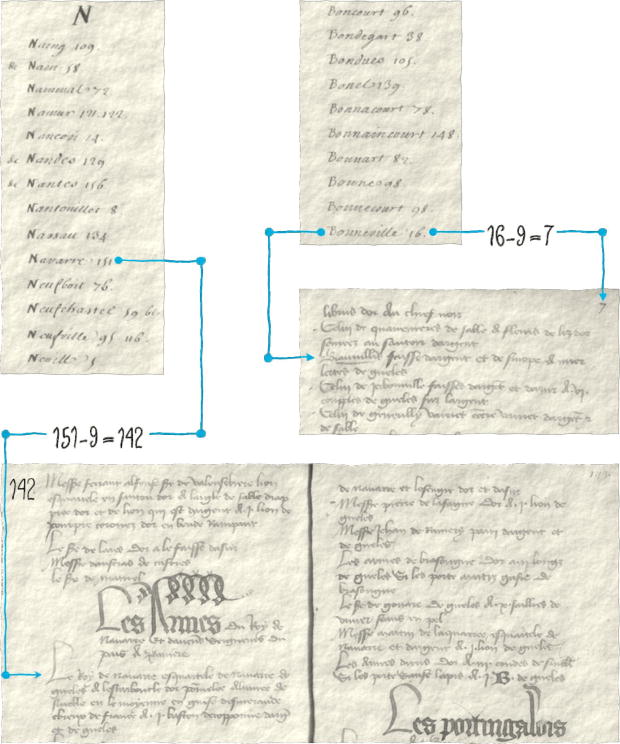
Urfé, unknown authors, «Urfe's Armorial», is currently in National Library of France (BnF, Bibliothèque nationale de France), in Paris, «Cabinet des titres» 927 as indicated on page I, cataloged with the code ms. fr. 32753, it is estimated from the XV century.
This armorial is written in French, on parchment measuring 19.5 x 14 centimeters, its compilation is believed to have been done in the 15th century, it presents 2,855 blazons in written form, but without illustrations, its blazons are organized into 54 sections, with an average of 17 blazons per page, the densest pages with about 20 blazons of 1, 2, or 3 lines per blazon, although some are longer. This Urfé armorial has served as a source for later armorials.
This manuscript contains a preliminary index, written later, of 61 pages, foliated the odd pages in consecutive Roman numerals from folio I to folio XXX. That is, 30 folios of 2 pages plus a final page, totaling 30 x 2 + 1 = 61 pages. This preliminary index consists of a name and a page number where the «theoretically», as will be explained below, corresponding blazon appears.
Next comes the true body of the Urfé armorial, of 162 pages, foliated only the odd pages, dated later than the compilation of the manuscript, in Arabic numerals, 2 by 2, from folio 1 to 161. That is, 1, 3, 5, 7, ..., 159, 161, and the last existing unnumbered page, as it is the 162nd which is even. I say that the 162nd is the last existing page because the National Library of France classifies it as an incomplete manuscript at the end.
It is a bit difficult to understand the relationship between the numbers that appear in the preliminary index, accompanying the names, and the numbering of the pages of the Urfé armorial. For example:
- Bouneville, which in the index appears with the number 16, is blazoned on page 7 (16 - 9 = 7).
- Navarre, for Navarra, in the index appears with the number 151, while the blazon of "Le Roy de Navarre" appears on page 142 (151 - 9 = 142).
This rule of subtracting 9, which has worked for me, but may not be of general use as, for example, Castille~Castile, on page VIII of the index, refers to page 140 of the content and it is there where it is actually found.
The Urfé armorial is in the public domain and the National Library of France, since February 23, 2012, has it published online with identification key ark:/12148/btv1b9063217v.
In this online version, as of today and until corrected, I believe that after page XIX, XVIII and XIX are repeated, just as folio 5 is repeated twice.
Bibliographical reference of century XV.
Classification: Armorial roll, Manuscript, In black and white and French language.
The author is unknown.
The following article cites this bibliographic reference:
External resources:
-
Language
-
Categories of heraldry
-
Divisions of the field
- Without divisions
- Party per pale
- Party per fess
- Party per bend
- Party per bend sinister
- Tierce
- Tierce sinister
- Tierced per pale
- Tierced per fess
- Tierced per bend
- Tierced pallwise inverted
- Quarterly
- Quarterly per saltire
- Gyronny
- Party per fess, the chief per pale
- Party per pale, the sinister per fess
- Party per fess, the base per pale
- Party per pale, the dexter per fess
- Chapé
- Chaussé
- Embrassé
- Contre-embrassé
- Party per chevron
- Enté
- Enté en point
- Flanched
-
Metals
-
Colours
-
Furs
-
Other tinctures
-
Ordinaries and sub-ordinaries
-
Diminutives of the ordinaries
-
Geometric charges
-
Composite ordinaries
-
Inanimate charges from Nature
Atom, Crescent, Diamond, Emerald, Estoile, Increscent, Lightning flash, Moon, Mount, Mullet, Mullet of four points, Orbital, Plough of Ursa Major, Rainbow, Ray of the sun, River, Sea, Snowflake, Sun, Sun in splendour, Sun of May, Trimount, Water and Wave.
-
Vegetal charges from Nature
Acorn, Apple, Apple tree, Ash, Bluebonnet, Camellia, Chrysanthemum, Cinquefoil, Cornflower, Dogwood flower, Double rose, Elm, Fleur de lis, Flower, Gourd, Holm oak, Hop cone, Kapok tree, Laurel, Lily, Linden, Lotus flower, Madonna lily, Mexican cedar tree, Oak, Olive tree, Palm tree, Plantain plant, Pomegranate, Poplar leaf, Rose, Shamrock, Sunflower, Thistle, Tree, Tulip, Vine and Wheat.
-
Animal charges from Nature
Badger, Bald eagle, Barbel, Barn owl, Bear, Beaver, Beetle, Bighorn sheep, Blackbird, Boar, Brach hound, Bull, Doe, Dog, Dolphin, Dove, Eagle, Elephant, Falcon, Female figure, Fish, Flame, Fly, Fox, Frog, Goat, Goldfinch, Goose, Heron, Horse, Hummingbird, Jaguar, Lark, Leopard, Lion, Lion passant, Lion rampant guardant, Lioness, Lynx, Male figure, Martlet, Merino ram, Owl, Panther, Parrot, Peacock, Pelican, Pelican in her piety, Puffin, Quetzal, Raven, Roe deer, Rooster, Savage, Seagull, Serpent, She-wolf, Stag, Starling, Talbot, Tyger, Vulture, Warren hound and Wolf.
-
Parts of natural charges
Arm, Beak, Branch, Caboshed, Chest, Claw, Covert, Dorsal fin, Eagle claw, Ermine spot, Escallop, Feather, Foot (palmiped), Foreleg, Forepaw, Hand, Head, Heart, Hoof, Leaf, Neck, Ostrich feather, Palm frond, Paw, Roe deers' attires, Shoulder, Sprig, Stags' attires, Stem, Swallow-tail, Tail, Tail addorsed, Tail fin, Talon, Tooth, Trunk, Trunk (elephant), Two hands clasped, Two wings in vol, Udder, Wheat spike, Wing and Wrist.
-
Artificial charges
Ace of spades, Anchor, Anvil, Arch, Arm vambraced, Armillary sphere, Arrow, Axe, Bell, Bell tower, Beret, Bonfire, Book, Bookmark, Bow, Branding iron, Bridge, Broken, Buckle, Cannon, Cannon dismounted, Cannon port, Canopy roof, Carbuncle, Castle, Celtic Trinity knot, Chain, Chess rooks, Church, Clarion, Clay pot, Closed book, Club, Column, Comb, Compass rose, Conductor's baton, Cord, Covered cup, Crozier, Crucible, Cuffed, Cup, Cyclamor, Dagger, Double vajra, Drum, Ecclesiastical cap, Fanon, Federschwert, Fleam, Four crescents joined millsailwise, Galician granary, Garb, Gauntlet, Geometric solid, Grenade, Halberd, Hammer, Harp, Host, Hourglass, Key, Key ward, Knight, Knot, Lantern, Letter, Line, Loincloth, Menorah, Millrind, Millstone, Millwheel, Monstrance, Mortar, Mullet of six points pierced, Nail, Non-classic artifact, Norman ship, Number, Oar, Oil lamp, Open book, Page, Pair of scales, Parchment, Pestle, Piano, Pilgrim's staff, Plough share, Polish winged hussar, Port, Portcullis, Potent, Quill, Ribbon, Rosette of acanthus leaves, Sabre, Sackbut, Sail, Scroll, Scythe, Sheaf of tobacco, Ship, Skirt, Spear, Spear's head, Stairway, Star of David, Step, Sword, Symbol, Tetrahedron, Torch, Tower, Trident, Trumpet, Turret, Two-handed sword, Wagon-wheel, Water-bouget, Wheel, Winnowing fan and With a turret.
-
Immaterial charges
Angel, Archangel, Basilisk, Dragon, Dragon's head, Garuda, Golden fleece, Griffin, Heart enflamed, Justice, Mermaid, Our Lady of Mercy, Ouroboros, Paschal lamb, Pegasus, Phoenix, Sacred Heart of Jesus, Saint George, Sea-griffin, Trinity, Triton, Unicorn, Winged hand and Wyvern.
-
External elements
-
Heraldic creations
-
References
-
Formats
-
Keywords on this page
Armed, Armorial roll, Azure, Bibliography, House of York, Quarterly, In black and white, In color, In pale, Armillary sphere, Fleur de lis, Gules, Incunabulum, Langued, German language, French language, Leopard, Manuscript, Ordered, Or, Kingdom of England, Century XV and Three.

